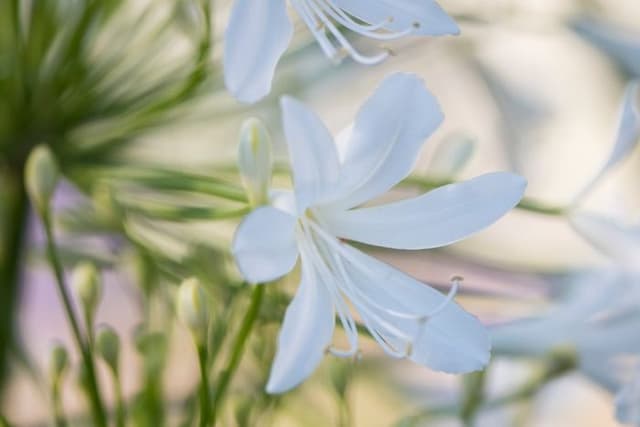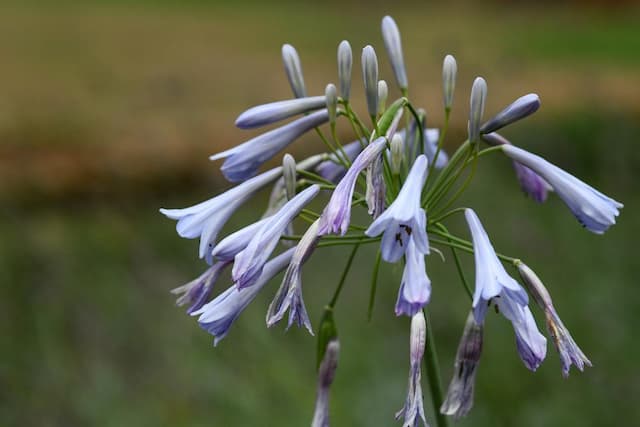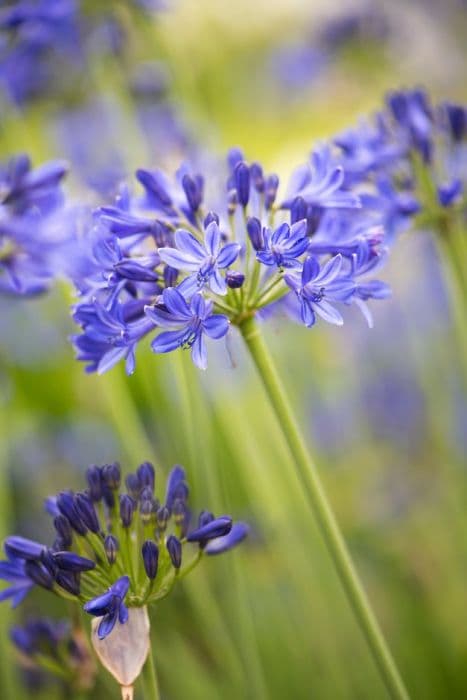Lily of the Nile Agapanthus 'Peter Franklin'

ABOUT
Agapanthus 'Peter Franklin' is a striking plant known for its lush green foliage and stunning flowers. The leaves are long, strap-like, and arch gracefully, creating an attractive fountain of greenery. These leaves provide a rich backdrop to the plant's showpiece—its flowers. The blooms of the Agapanthus 'Peter Franklin' consist of bold, globe-shaped clusters of individual flowers perched atop tall, sturdy stems that rise above the foliage. Each cluster, known as an umbel, is made up of numerous trumpet-shaped flowers with a cool blue hue, having a vivid and refreshing look. The petals have a delicate texture and may show a gradient of color, ranging from a deeper blue at the base to a lighter shade at the tips, sometimes edged with a hint of white. The overall appearance of the plant is elegant and eye-catching, making it a popular choice for ornamental gardens. The luscious blooms tend to appear during the warmer months, providing a long season of visual interest.
About this plant
 Names
NamesFamily
Amaryllidaceae
Synonyms
African Lily, Lily of the Nile, Love Flower
Common names
Agapanthus 'Peter Franklin'.
 Toxicity
ToxicityTo humans
The Agapanthus, also known as Lily of the Nile or African Lily, has parts that are considered toxic if ingested. All parts of the plant contain compounds that can cause symptoms such as nausea, vomiting, and diarrhea if ingested in significant quantities. Handling the plant may also cause skin irritation in some individuals. It is advisable to exercise caution and prevent ingestion, especially in children and vulnerable individuals.
To pets
The Agapanthus or Lily of the Nile poses a risk of toxicity to pets such as dogs and cats if ingested. The plant contains substances that can cause gastrointestinal upset, with symptoms including vomiting, diarrhea, and occasionally more severe reactions depending on the amount consumed. It is important to keep pets away from the plant to avoid the risk of poisoning.
 Characteristics
CharacteristicsLife cycle
Perennials
Foliage type
Evergreen
Color of leaves
Green
Flower color
Blue
Height
2 feet [60 cm]
Spread
2 feet [60 cm]
Plant type
Bulb
Hardiness zones
8
Native area
South Africa
Benefits
 General Benefits
General Benefits- Ornamental Value: Agapanthus 'Peter Franklin', commonly known as the African Lily, adds aesthetic appeal to gardens with its striking blue or purple flowers.
- Low Maintenance: African Lily is easy to care for, requiring minimal upkeep once established, making it suitable for gardeners of all skill levels.
- Drought Tolerance: Once established, it has a good level of drought tolerance, making it suitable for dry climates or water-wise gardens.
- Long Blooming: This plant has a long flowering period, which provides colour and interest in the garden for an extended time.
- Attracts Pollinators: The flowers of the African Lily attract bees, butterflies, and other beneficial pollinators, supporting local ecosystems.
- Versatility: Suitable for planting in borders, containers, and as a focal point, offering flexibility in garden design.
- Deer Resistance: They are somewhat resistant to deer, which can help in areas where deer browsing is an issue.
 Medical Properties
Medical PropertiesThis plant is not used for medical purposes.
 Air-purifying Qualities
Air-purifying QualitiesThis plant is not specifically known for air purifying qualities.
 Other Uses
Other Uses- Agapanthus, commonly known as Lily of the Nile, can be used as a natural dye, where the flowers provide hues of blue to violet, suitable for coloring fabrics or artwork.
- In floristry, the long-lasting nature of Agapanthus blooms makes them ideal for use in floral arrangements and bridal bouquets, adding structure and height.
- The sap from Agapanthus can be used as a base for natural adhesives when mixed with other plant-based substances.
- Lily of the Nile can serve as an educational tool in botanical studies, where students can learn about plant structure, reproduction, and hybridization techniques.
- The strong, fibrous leaves of Agapanthus can be woven or braided into small handicrafts such as baskets or mats, showcasing traditional crafting skills.
- The plant can be used in landscape design to prevent soil erosion due to its robust root system that holds the soil firmly.
- During festive seasons, dried Agapanthus flowers are often incorporated into wreaths and Christmas decorations for their distinct shape and texture.
- In photography, Agapanthus provides an aesthetic backdrop with its lush foliage and striking blue to purple flowers, ideal for nature and garden scenes.
- Lily of the Nile can be used in garden ponds as a transitional plant to create a harmonious bridge between the water and land elements in water gardens.
- The robust nature of Agapanthus makes it a good candidate for use in urban green spaces, where it can add vibrancy to public parks and withstand city conditions.
Interesting Facts
 Feng Shui
Feng ShuiThe African Lily is not used in Feng Shui practice.
 Zodiac Sign Compitability
Zodiac Sign CompitabilityThe African Lily is not used in astrology practice.
 Plant Symbolism
Plant Symbolism- Love Letters: The name 'Agapanthus' is derived from the Greek words 'agape' (love) and 'anthos' (flower), suggesting a symbolism of love or a message of love in bloom.
- Beauty: With its striking blue to purple flowers, the Agapanthus is commonly associated with beauty and an appreciation for the aesthetics.
- Strength and Resilience: Agapanthus plants are known for their hardiness and ability to thrive in a variety of conditions, symbolizing strength and resilience in the face of adversity.
 Water
WaterLily of the Nile requires consistent moisture and should be watered deeply every week, allowing the soil to dry slightly between waterings. During the growing season in spring and summer, increase watering to twice per week, providing about one gallon of water per plant each time. Over the winter months, reduce watering to every other week, considering rainfall, as the plant is dormant during this period. It's important not to overwater, as this can lead to root rot.
 Light
LightLily of the Nile thrives best in full sun to partial shade. Ideally, the plant should receive at least six hours of sunlight per day. A spot that offers morning sun and afternoon shade is optimal, especially in hotter climates where intense afternoon sun can scorch the foliage.
 Temperature
TemperatureLily of the Nile prefers moderate to warm temperatures and is hardy in USDA zones 8 through 11. It can survive minimum winter temperatures down to about 20° Fahrenheit. During active growth, the ideal temperature range is between 60°F and 85°F. These plants may require protection or mulching in areas where temperatures fall below the minimum threshold.
 Pruning
PruningPruning Lily of the Nile is done primarily to remove spent flower stalks, which encourages new growth and tidies up the plant. Deadhead the flowers after they fade and prune back the foliage only if it becomes damaged or dies back in winter. The best time to prune is late winter or early spring before new growth starts.
 Cleaning
CleaningAs needed
 Soil
SoilLily of the Nile (Agapanthus 'Peter Franklin') prefers a soil mix that is well-draining and fertile, composed of loam, sand, and organic compost in equal parts. The ideal soil pH for this plant ranges between 6.0 and 7.0, which is slightly acidic to neutral.
 Repotting
RepottingLily of the Nile should be repotted every 3 to 4 years, or when the clumps become overcrowded. This will ensure that the plant continues to have enough space to grow and receive adequate nutrients from fresh soil.
 Humidity & Misting
Humidity & MistingLily of the Nile thrives best in moderate humidity conditions. It does not require high humidity and can tolerate the average humidity levels found in most outdoor environments.
 Suitable locations
Suitable locationsIndoor
Place Lily of the Nile in bright, indirect sunlight indoors.
Outdoor
Plant Lily of the Nile in a sunny spot with partial shade.
Hardiness zone
8-11 USDA
 Life cycle
Life cycleAgapanthus 'Peter Franklin', also commonly known as Lily of the Nile, begins its life cycle as a dormant bulb or rhizome during winter. In early spring, it starts to produce strap-shaped leaves, creating a lush, green clump. As the growing season progresses, usually by mid to late summer, the plant sends up tall flower stalks topped with globe-shaped clusters of tubular, blue or purple flowers. After flowering, seed pods may form, which eventually dry and release seeds, although many cultivars are propagated through division rather than seeds. Once the blooming period is over, the foliage continues to photosynthesize and store energy before dying back as temperatures drop in the fall. The plant then re-enters dormancy, with the bulb or rhizome resting underground until the following spring when the cycle starts anew.
 Propogation
PropogationPropogation time
Spring-Early Summer
Propogation: The most popular method of propagating the Agapanthus 'Peter Franklin', commonly known as Lily of the Nile, is through division. Typically, the best time to propagate by division is in the spring after the threat of frost has passed or in early fall, which allows the new divisions to establish before the onset of winter. To propagate by division, carefully lift the entire plant from the ground using a garden fork, taking care not to damage the roots. Gently tease apart the clump into smaller sections, each with a portion of roots and at least one or two growing points or shoots. Replant the divisions at the same depth they were growing previously, spacing them about 12 to 18 inches (approximately 30 to 45 centimeters) apart to give them room to mature. Water the new plants thoroughly to settle the soil around the roots and establish a good contact between the soil and the root system.







![African lily [Brilliant Blue]](/_next/image?url=https%3A%2F%2Fplants-admin.emdemapps.com%2Fimages%2Fplants%2F%2Fimages%2F604b5e3c28e2b.png&w=640&q=75)

